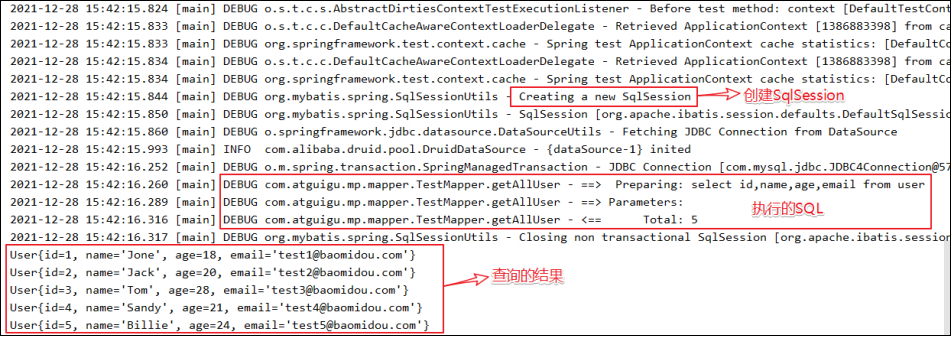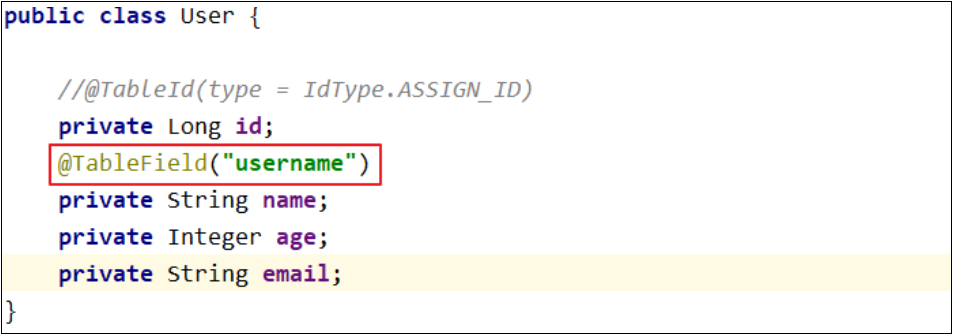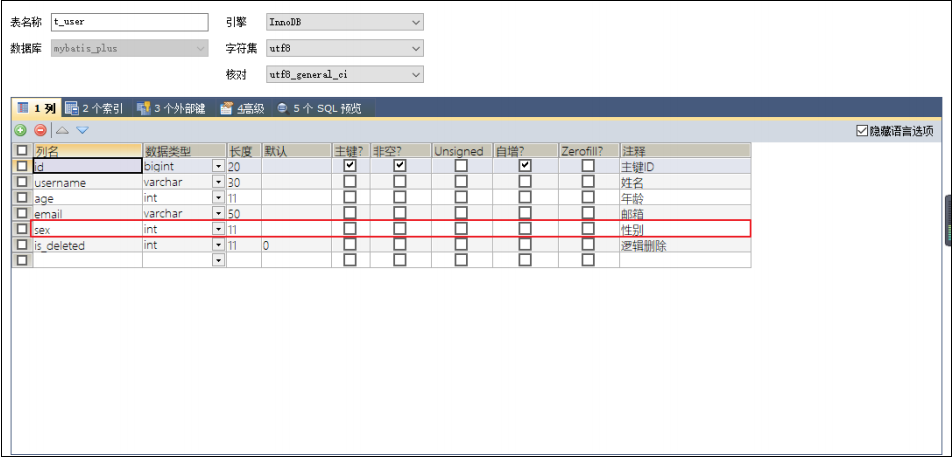一、MyBatis-Plus简介
1、简介
MyBatis-Plus(简称 MP)是一个 MyBatis的增强工具,在 MyBatis 的基础上只做增强不做改变,为简化开发、提高效率而生。
愿景 我们的愿景是成为 MyBatis 最好的搭档,就像魂斗罗中的 1P、2P,基友搭配,效率翻倍。
2、特性
- 无侵入:只做增强不做改变,引入它不会对现有工程产生影响,如丝般顺滑
- 损耗小:启动即会自动注入基本 CURD,性能基本无损耗,直接面向对象操作
- 强大的 CRUD 操作:内置通用 Mapper、通用 Service,仅仅通过少量配置即可实现单表大部分CRUD 操作,更有强大的条件构造器,满足各类使用需求
- 支持 Lambda 形式调用:通过 Lambda 表达式,方便的编写各类查询条件,无需再担心字段写错
- 支持主键自动生成:支持多达 4 种主键策略(内含分布式唯一 ID 生成器 - Sequence),可自由配置,完美解决主键问题
- 支持 ActiveRecord 模式:支持 ActiveRecord 形式调用,实体类只需继承 Model 类即可进行强大的 CRUD 操作
- 支持自定义全局通用操作:支持全局通用方法注入( Write once, use anywhere )
- 内置代码生成器:采用代码或者 Maven 插件可快速生成 Mapper 、 Model 、 Service 、Controller 层代码,支持模板引擎,更有超多自定义配置等您来使用
- 内置分页插件:基于 MyBatis 物理分页,开发者无需关心具体操作,配置好插件之后,写分页等同于普通 List 查询
- 分页插件支持多种数据库:支持 MySQL、MariaDB、Oracle、DB2、H2、HSQL、SQLite、Postgre、SQLServer 等多种数据库
- 内置性能分析插件:可输出 SQL 语句以及其执行时间,建议开发测试时启用该功能,能快速揪出慢查询
内置全局拦截插件:提供全表 delete 、 update 操作智能分析阻断,也可自定义拦截规则,预防误操作
3、支持数据库
任何能使用MyBatis进行 CRUD, 并且支持标准 SQL 的数据库,具体支持情况如下
MySQL,Oracle,DB2,H2,HSQL,SQLite,PostgreSQL,SQLServer,Phoenix,Gauss ,ClickHouse,Sybase,OceanBase,Firebird,Cubrid,Goldilocks,csiidb
- 达梦数据库,虚谷数据库,人大金仓数据库,南大通用(华库)数据库,南大通用数据库,神通数据库,瀚高数据库
4、框架结构
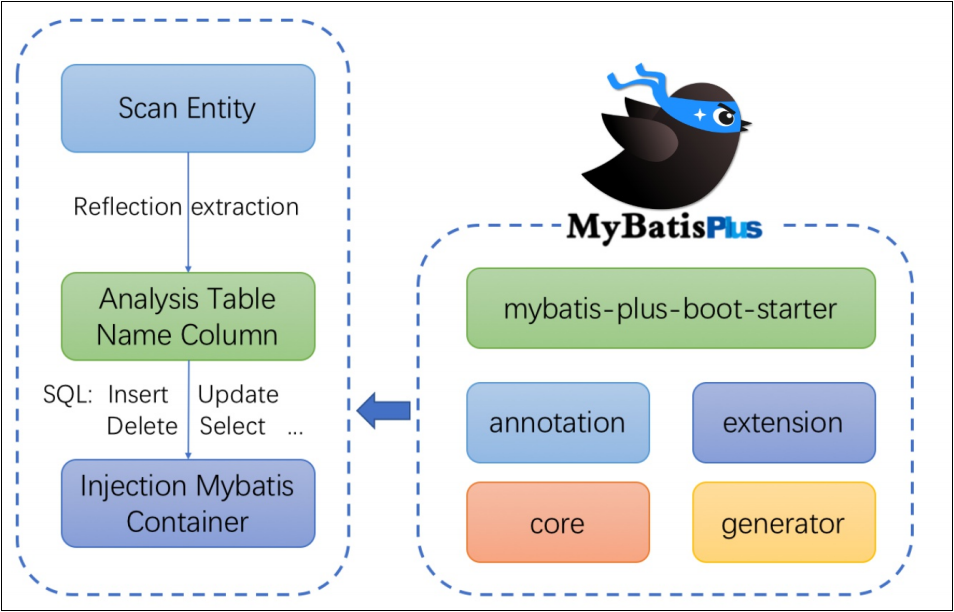
5、代码及文档地址
官方地址:http://mp.baomidou.com
代码发布地址:
Github:https://github.com/baomidou/mybatis-plus
Gitee:https://gitee.com/baomidou/mybatis-plus
文档发布地址:https://baomidou.com/pages/24112f二、入门案例
MyBatis-Plus官方推荐使用Spring Boot,在此我们以Spring整合MyBatis为基础,再加入MyBatis-plus,以此来学习MyBatis-Plus相关内容
1、开发环境
IDE:idea 2019.2
JDK:JDK8+
构建工具:maven 3.5.4
MySQL版本:MySQL 5.7
Spring:5.3.1
MyBatis-Plus:3.4.3.4
2、创建数据库及表
a>创建表
CREATE DATABASE `mybatis_plus` /*!40100 DEFAULT CHARACTER SET utf8mb4 */;use `mybatis_plus`;CREATE TABLE `user` (`id` bigint(20) NOT NULL COMMENT '主键ID',`name` varchar(30) DEFAULT NULL COMMENT '姓名',`age` int(11) DEFAULT NULL COMMENT '年龄',`email` varchar(50) DEFAULT NULL COMMENT '邮箱',PRIMARY KEY (`id`)) ENGINE=InnoDB DEFAULT CHARSET=utf8;
b>添加数据
INSERT INTO user (id, name, age, email) VALUES(1, 'Jone', 18, 'test1@baomidou.com'),(2, 'Jack', 20, 'test2@baomidou.com'),(3, 'Tom', 28, 'test3@baomidou.com'),(4, 'Sandy', 21, 'test4@baomidou.com'),(5, 'Billie', 24, 'test5@baomidou.com');
3、创建maven工程
a>打包方式:jar
b>引入依赖
<packaging>jar</packaging><properties><spring.version>5.3.1</spring.version></properties><dependencies><dependency><groupId>org.springframework</groupId><artifactId>spring-context</artifactId><version>${spring.version}</version></dependency><dependency><groupId>org.springframework</groupId><artifactId>spring-jdbc</artifactId><version>${spring.version}</version></dependency><dependency><groupId>org.springframework</groupId><artifactId>spring-test</artifactId><version>${spring.version}</version></dependency><!-- 连接池 --><dependency><groupId>com.alibaba</groupId><artifactId>druid</artifactId><version>1.2.8</version></dependency><!-- junit测试 --><dependency><groupId>junit</groupId><artifactId>junit</artifactId><version>4.12</version><scope>test</scope></dependency><!-- MySQL驱动 --><dependency><groupId>mysql</groupId><artifactId>mysql-connector-java</artifactId><version>8.0.27</version></dependency><!-- 日志 --><dependency><groupId>org.slf4j</groupId><artifactId>slf4j-api</artifactId><version>1.7.30</version></dependency><dependency><groupId>ch.qos.logback</groupId><artifactId>logback-classic</artifactId><version>1.2.3</version></dependency><!-- lombok用来简化实体类 --><dependency><groupId>org.projectlombok</groupId><artifactId>lombok</artifactId><version>1.16.16</version></dependency><!--MyBatis-Plus的核心依赖--><dependency><groupId>com.baomidou</groupId><artifactId>mybatis-plus</artifactId><version>3.4.3.4</version></dependency></dependencies>
注意: Spring整合MyBatis,需要MyBatis以及Spring整合MyBatis的依赖:
但是,在以上的依赖列表中,并没有MyBatis以及Spring整合MyBatis的依赖,因为当我们引入了MyBatis-Plus的依赖时,就可以间接的引入这些依赖
并且依赖和依赖之间的版本必须兼容,所以我们不能随便引入其他版本的依赖,以免发生冲突在官网上有明确提示:
4、Spring整合MyBatis
a>创建实体
public class User {private Long id;private String name;private Integer age;private String email;public User() {}public User(Long id, String name, Integer age, String email) {this.id = id;this.name = name;this.age = age;this.email = email;}public Long getId() {return id;}public void setId(Long id) {this.id = id;}public String getName() {return name;}public void setName(String name) {this.name = name;}public Integer getAge() {return age;}public void setAge(Integer age) {this.age = age;}public String getEmail() {return email;}public void setEmail(String email) {this.email = email;}@Overridepublic String toString() {return "User{" +"id=" + id +", name='" + name + '\'' +", age=" + age +", email='" + email + '\'' +'}';}}
b>创建MyBatis的核心配置文件
在resources下创建mybatis-config.xml
<?xml version="1.0" encoding="UTF-8" ?><!DOCTYPE configurationPUBLIC "-//mybatis.org//DTD Config 3.0//EN""http://mybatis.org/dtd/mybatis-3-config.dtd"><configuration></configuration>
c>创建mapper接口和映射文件
mapper接口:
public interface TestMapper {/*** 查询所有用户信息* @return*/List<User> getAllUser();}
mapper映射文件:
在resources下的com/atguigu/mp/mapper目录下创建TestMapper.xml
<?xml version="1.0" encoding="UTF-8" ?><!DOCTYPE mapperPUBLIC "-//mybatis.org//DTD Mapper 3.0//EN""http://mybatis.org/dtd/mybatis-3-mapper.dtd"><mapper namespace="com.atguigu.mp.mapper.TestMapper"><!--SQL片段,记录基础字段--><sql id="BaseColumns">id,name,age,email</sql><!--List<User> getAllUser();--><select id="getAllUser" resultType="User">select <include refid="BaseColumns"></include> from user</select></mapper>
d>创建jdbc.properties
在resources下创建jdbc.properties
jdbc.driver=com.mysql.jdbc.Driverjdbc.url=jdbc:mysql://localhost:3306/mybatis_plus?useUnicode=true&characterEncoding=utf-8&useSSL=falsejdbc.username=rootjdbc.password=123456
e>创建Spring的配置文件
在resources下创建applicationContext.xml
<?xml version="1.0" encoding="UTF-8"?><beans xmlns="http://www.springframework.org/schema/beans"xmlns:xsi="http://www.w3.org/2001/XMLSchema-instance"xmlns:context="http://www.springframework.org/schema/context"xsi:schemaLocation="http://www.springframework.org/schema/beanshttp://www.springframework.org/schema/beans/spring-beans.xsdhttp://www.springframework.org/schema/contexthttps://www.springframework.org/schema/context/spring-context.xsd"><!-- 引入jdbc.properties --><context:property-placeholder location="classpath:jdbc.properties"></context:property-placeholder><!-- 配置Druid数据源 --><bean id="dataSource" class="com.alibaba.druid.pool.DruidDataSource"><property name="driverClassName" value="${jdbc.driver}"></property><property name="url" value="${jdbc.url}"></property><property name="username" value="${jdbc.username}"></property><property name="password" value="${jdbc.password}"></property></bean><!-- 配置用于创建SqlSessionFactory的工厂bean --><bean class="org.mybatis.spring.SqlSessionFactoryBean"><!-- 设置MyBatis配置文件的路径(可以不设置) --><property name="configLocation" value="classpath:mybatis-config.xml"></property><!-- 设置数据源 --><property name="dataSource" ref="dataSource"></property><!-- 设置类型别名所对应的包 --><property name="typeAliasesPackage" value="com.atguigu.mp.pojo"></property><!--设置映射文件的路径若映射文件所在路径和mapper接口所在路径一致,则不需要设置--><!--<property name="mapperLocations" value="classpath:mapper/*.xml"></property>--></bean><!--配置mapper接口的扫描配置由mybatis-spring提供,可以将指定包下所有的mapper接口创建动态代理并将这些动态代理作为IOC容器的bean管理--><bean class="org.mybatis.spring.mapper.MapperScannerConfigurer"><property name="basePackage" value="com.atguigu.mp.mapper"></property></bean></beans>
f>添加日志功能
在resources下创建logback.xml
<?xml version="1.0" encoding="UTF-8"?><configuration debug="false"><!--定义日志文件的存储地址 logs为当前项目的logs目录 还可以设置为../logs --><property name="LOG_HOME" value="logs" /><!--控制台日志, 控制台输出 --><appender name="STDOUT" class="ch.qos.logback.core.ConsoleAppender"><encoder class="ch.qos.logback.classic.encoder.PatternLayoutEncoder"><!--格式化输出:%d表示日期,%thread表示线程名,%-5level:级别从左显示5个字符宽度,%msg:日志消息,%n是换行符--><pattern>%d{yyyy-MM-dd HH:mm:ss.SSS} [%thread] %-5level %logger{50}- %msg%n</pattern></encoder></appender><!--myibatis log configure--><logger name="com.apache.ibatis" level="TRACE"/><logger name="java.sql.Connection" level="DEBUG"/><logger name="java.sql.Statement" level="DEBUG"/><logger name="java.sql.PreparedStatement" level="DEBUG"/><!-- 日志输出级别 --><root level="DEBUG"><appender-ref ref="STDOUT" /></root></configuration>
g>测试
方式一:通过IOC容器
public class MyBatisPlusTest {@Testpublic void testMyBatis(){ApplicationContext ac = newClassPathXmlApplicationContext("applicationContext.xml");TestMapper mapper = ac.getBean(TestMapper.class);mapper.getAllUser().forEach(user -> System.out.println(user));}}
方式二:Spring整合junit
//在Spring的环境中进行测试@RunWith(SpringJUnit4ClassRunner.class)//指定Spring的配置文件@ContextConfiguration("classpath:applicationContext.xml")public class MyBatisPlusTest {@Autowiredprivate TestMapper testMapper;@Testpublic void testMyBatisBySpring(){testMapper.getAllUser().forEach(user -> System.out.println(user));}}
5、加入MyBatis-Plus
a>修改applicationContext.xml
Spring整合MyBatis
<!-- 配置用于创建SqlSessionFactory的工厂bean --><bean class="org.mybatis.spring.SqlSessionFactoryBean"><!-- 设置MyBatis配置文件的路径(可以不设置) --><property name="configLocation" value="classpath:mybatis-config.xml"></property><!-- 设置数据源 --><property name="dataSource" ref="dataSource"></property><!-- 设置类型别名所对应的包 --><property name="typeAliasesPackage" value="com.atguigu.mp.pojo"></property><!--设置映射文件的路径若映射文件所在路径和mapper接口所在路径一致,则不需要设置--><!--<property name="mapperLocations" value="classpath:mapper/*.xml"></property>--></bean>
加入MyBatis-Plus之后
<!-- 此处使用的是MybatisSqlSessionFactoryBean --><bean class="com.baomidou.mybatisplus.extension.spring.MybatisSqlSessionFactoryBean"><!-- 设置MyBatis配置文件的路径(可以不设置) --><property name="configLocation" value="classpath:mybatis-config.xml"></property><!-- 设置数据源 --><property name="dataSource" ref="dataSource"></property><!-- 设置类型别名所对应的包 --><property name="typeAliasesPackage" value="com.atguigu.mp.pojo"></property><!--设置映射文件的路径若映射文件所在路径和mapper接口所在路径一致,则不需要设置--><!--<property name="mapperLocations" value="classpath:mapper/*.xml"></property>--></bean>
此处使用的是MybatisSqlSessionFactoryBean 经观察,目前bean中配置的属性和SqlSessionFactoryBean一致 MybatisSqlSessionFactoryBean是在SqlSessionFactoryBean的基础上进行了增强 即具有SqlSessionFactoryBean的基础功能,又具有MyBatis-Plus的扩展配置 具体配置信息地址:https://baomidou.com/pages/56bac0/#%E5%9F%BA%E6%9C%AC%E9% 85%8D%E7%BD%AE
b>创建mapper接口
public interface UserMapper extends BaseMapper<User> {}
BaseMapper是MyBatis-Plus提供的基础mapper接口,泛型为所操作的实体类型,其中包含 CRUD的各个方法,我们的mapper继承了BaseMapper之后,就可以直接使用BaseMapper所提 供的各种方法,而不需要编写映射文件以及SQL语句,大大的提高了开发效率
c>测试
@RunWith(SpringJUnit4ClassRunner.class)@ContextConfiguration("classpath:applicationContext.xml")public class MyBatisPlusTest {@Autowiredprivate UserMapper userMapper;@Testpublic void testMyBatisPlus(){//根据id查询用户信息System.out.println(userMapper.selectById(1));}}
d>结果
6、总结
在Spring整合MyBatis中加入了MyBatis-Plus后,我们就可以使用MyBatis-Plus所提供的BaseMapper实现CRUD,并不需要编写映射文件以及SQL语句但是若要自定义SQL语句,仍然可以编写映射文件而不造成任何影响因为MyBatis-Plus只做增强,而不做改变
三、基本CRUD
1、BaseMapper
MyBatis-Plus中的基本CRUD在内置的BaseMapper中都已得到了实现,我们可以直接使用,接口如下:
package com.baomidou.mybatisplus.core.mapper;public interface BaseMapper<T> extends Mapper<T> {/*** 插入一条记录* @param entity 实体对象*/int insert(T entity);/*** 根据 ID 删除* @param id 主键ID*/int deleteById(Serializable id);/*** 根据实体(ID)删除* @param entity 实体对象* @since 3.4.4*/int deleteById(T entity);/*** 根据 columnMap 条件,删除记录* @param columnMap 表字段 map 对象*/int deleteByMap(@Param(Constants.COLUMN_MAP) Map<String, Object> columnMap);/*** 根据 entity 条件,删除记录* @param queryWrapper 实体对象封装操作类(可以为 null,里面的 entity 用于生成 where语句)*/int delete(@Param(Constants.WRAPPER) Wrapper<T> queryWrapper);/*** 删除(根据ID 批量删除)* @param idList 主键ID列表(不能为 null 以及 empty)*/int deleteBatchIds(@Param(Constants.COLLECTION) Collection<? extendsSerializable> idList);/*** 根据 ID 修改* @param entity 实体对象*/int updateById(@Param(Constants.ENTITY) T entity);/*** 根据 whereEntity 条件,更新记录* @param entity 实体对象 (set 条件值,可以为 null)* @param updateWrapper 实体对象封装操作类(可以为 null,里面的 entity 用于生成where 语句)*/int update(@Param(Constants.ENTITY) T entity, @Param(Constants.WRAPPER)Wrapper<T> updateWrapper);/*** 根据 ID 查询* @param id 主键ID*/T selectById(Serializable id);/*** 查询(根据ID 批量查询)* @param idList 主键ID列表(不能为 null 以及 empty)*/List<T> selectBatchIds(@Param(Constants.COLLECTION) Collection<? extendsSerializable> idList);/*** 查询(根据 columnMap 条件)* @param columnMap 表字段 map 对象*/List<T> selectByMap(@Param(Constants.COLUMN_MAP) Map<String, Object>columnMap);/*** 根据 entity 条件,查询一条记录* <p>查询一条记录,例如 qw.last("limit 1") 限制取一条记录, 注意:多条数据会报异常</p>* @param queryWrapper 实体对象封装操作类(可以为 null)*/default T selectOne(@Param(Constants.WRAPPER) Wrapper<T> queryWrapper) {List<T> ts = this.selectList(queryWrapper);if (CollectionUtils.isNotEmpty(ts)) {if (ts.size() != 1) {throw ExceptionUtils.mpe("One record is expected, but the queryresult is multiple records");}return ts.get(0);}return null;}/*** 根据 Wrapper 条件,查询总记录数* @param queryWrapper 实体对象封装操作类(可以为 null)*/Long selectCount(@Param(Constants.WRAPPER) Wrapper<T> queryWrapper);/*** 根据 entity 条件,查询全部记录* @param queryWrapper 实体对象封装操作类(可以为 null)*/List<T> selectList(@Param(Constants.WRAPPER) Wrapper<T> queryWrapper);/*** 根据 Wrapper 条件,查询全部记录* @param queryWrapper 实体对象封装操作类(可以为 null)*/List<Map<String, Object>> selectMaps(@Param(Constants.WRAPPER) Wrapper<T>queryWrapper);/*** 根据 Wrapper 条件,查询全部记录* <p>注意: 只返回第一个字段的值</p>* @param queryWrapper 实体对象封装操作类(可以为 null)*/List<Object> selectObjs(@Param(Constants.WRAPPER) Wrapper<T> queryWrapper);/*** 根据 entity 条件,查询全部记录(并翻页)* @param page 分页查询条件(可以为 RowBounds.DEFAULT)* @param queryWrapper 实体对象封装操作类(可以为 null)*/<P extends IPage<T>> P selectPage(P page, @Param(Constants.WRAPPER)Wrapper<T> queryWrapper);/*** 根据 Wrapper 条件,查询全部记录(并翻页)* @param page 分页查询条件* @param queryWrapper 实体对象封装操作类*/<P extends IPage<Map<String, Object>>> P selectMapsPage(P page,@Param(Constants.WRAPPER) Wrapper<T> queryWrapper);}
2、插入
@Testpublic void testInsert(){User user = new User(null, "张三", 23, "zhangsan@atguigu.com");//INSERT INTO user ( id, name, age, email ) VALUES ( ?, ?, ?, ? )int result = userMapper.insert(user);System.out.println("受影响行数:"+result);//1475754982694199298System.out.println("id自动获取:"+user.getId());}
最终执行的结果,所获取的id为1475754982694199298 这是因为MyBatis-Plus在实现插入数据时,会默认基于雪花算法的策略生成id
3、删除
a>通过id删除记录
@Testpublic void testDeleteById(){//通过id删除用户信息//DELETE FROM user WHERE id=?int result = userMapper.deleteById(1475754982694199298L);System.out.println("受影响行数:"+result);}
b>通过id批量删除记录
@Testpublic void testDeleteBatchIds(){//通过多个id批量删除//DELETE FROM user WHERE id IN ( ? , ? , ? )List<Long> idList = Arrays.asList(1L, 2L, 3L);int result = userMapper.deleteBatchIds(idList);System.out.println("受影响行数:"+result);}
c>通过map条件删除记录
@Testpublic void testDeleteByMap(){//根据map集合中所设置的条件删除记录//DELETE FROM user WHERE name = ? AND age = ?Map<String, Object> map = new HashMap<>();map.put("age", 23);map.put("name", "张三");int result = userMapper.deleteByMap(map);System.out.println("受影响行数:"+result);}
4、修改
@Testpublic void testUpdateById(){User user = new User(4L, "admin", 22, null);//UPDATE user SET name=?, age=? WHERE id=?int result = userMapper.updateById(user);System.out.println("受影响行数:"+result);}
5、查询
a>根据id查询用户信息
@Testpublic void testSelectById(){//根据id查询用户信息//SELECT id,name,age,email FROM user WHERE id=?User user = userMapper.selectById(4L);System.out.println(user);}
b>根据多个id查询多个用户信息
@Testpublic void testSelectBatchIds(){//根据多个id查询多个用户信息//SELECT id,name,age,email FROM user WHERE id IN ( ? , ? )List<Long> idList = Arrays.asList(4L, 5L);List<User> list = userMapper.selectBatchIds(idList);list.forEach(System.out::println);}
c>通过map条件查询用户信息
@Testpublic void testSelectByMap(){//通过map条件查询用户信息//SELECT id,name,age,email FROM user WHERE name = ? AND age = ?Map<String, Object> map = new HashMap<>();map.put("age", 22);map.put("name", "admin");List<User> list = userMapper.selectByMap(map);list.forEach(System.out::println);}
d>查询所有数据
@Testpublic void testSelectList(){//查询所有用户信息//SELECT id,name,age,email FROM userList<User> list = userMapper.selectList(null);list.forEach(System.out::println);}
通过观察BaseMapper中的方法,大多方法中都有Wrapper类型的形参,此为条件构造器,可针对于SQL语句设置不同的条件,若没有条件,则可以为该形参赋值null,即查询(删除/修改)所有数据
6、通用Service
说明:
- 通用 Service CRUD 封装IService接口,进一步封装 CRUD 采用 get 查询单行 remove 删除 list 查询集合 page 分页 前缀命名方式区分 Mapper 层避免混淆,
- 泛型 T 为任意实体对象
- 建议如果存在自定义通用 Service 方法的可能,请创建自己的 IBaseService 继承Mybatis-Plus 提供的基类
- 官网地址:https://baomidou.com/pages/49cc81/#service-crud-%E6%8E%A5%E5%8F%A3
a>IService
MyBatis-Plus中有一个接口 IService和其实现类 ServiceImpl,封装了常见的业务层逻辑详情查看源码IService和ServiceImpl
b>创建Service接口和实现类
/*** UserService继承IService模板提供的基础功能*/public interface UserService extends IService<User> {}
/*** ServiceImpl实现了IService,提供了IService中基础功能的实现* 若ServiceImpl无法满足业务需求,则可以使用自定的UserService定义方法,并在实现类中实现*/@Servicepublic class UserServiceImpl extends ServiceImpl<UserMapper, User> implementsUserService {}
c>扫描组件
在applicationContext.xml中添加扫描组件的配置,扫描业务层组件,用于测试
<context:component-scan base-package="com.atguigu.mp.service.impl"></context:component-scan>
d>测试查询记录数
@Autowiredprivate UserService userService;@Testpublic void testGetCount(){long count = userService.count();System.out.println("总记录数:" + count);}
e>测试批量插入
@Testpublic void testSaveBatch(){// SQL长度有限制,海量数据插入单条SQL无法实行,// 因此MP将批量插入放在了通用Service中实现,而不是通用MapperArrayList<User> users = new ArrayList<>();for (int i = 0; i < 5; i++) {User user = new User();user.setName("ybc" + i);user.setAge(20 + i);users.add(user);}//SQL:INSERT INTO t_user ( username, age ) VALUES ( ?, ? )userService.saveBatch(users);}
四、常用注解
1、@TableName
经过以上的测试,在使用MyBatis-Plus实现基本的CRUD时,我们并没有指定要操作的表,只是在Mapper接口继承BaseMapper时,设置了泛型User,而操作的表为user表 由此得出结论,MyBatis-Plus在确定操作的表时,由BaseMapper的泛型决定,即实体类型决定,且默认操作的表名和实体类型的类名一致
a>问题
若实体类类型的类名和要操作的表的表名不一致,会出现什么问题? 我们将表user更名为t_user,测试查询功能 程序抛出异常,Table ‘mybatis_plus.user’ doesn’t exist,因为现在的表名为t_user,而默认操作的表名和实体类型的类名一致,即user表
b>通过@TableName解决问题
在实体类类型上添加@TableName(“t_user”),标识实体类对应的表,即可成功执行SQL语句
c>通过GlobalConfig解决问题
在开发的过程中,我们经常遇到以上的问题,即实体类所对应的表都有固定的前缀,例如t或tbl 此时,可以使用MyBatis-Plus提供的全局配置,为实体类所对应的表名设置默认的前缀,那么就不需要在每个实体类上通过@TableName标识实体类对应的表
<beanclass="com.baomidou.mybatisplus.extension.spring.MybatisSqlSessionFactoryBean"><property name="configLocation" value="classpath:mybatis-config.xml"></property><property name="dataSource" ref="dataSource"></property><property name="typeAliasesPackage" value="com.atguigu.mp.pojo"></property><!-- 设置MyBatis-Plus的全局配置 --><property name="globalConfig" ref="globalConfig"></property></bean><bean id="globalConfig"class="com.baomidou.mybatisplus.core.config.GlobalConfig"><property name="dbConfig"><beanclass="com.baomidou.mybatisplus.core.config.GlobalConfig$DbConfig"><!-- 设置实体类所对应的表的前缀 --><property name="tablePrefix" value="t_"></property></bean></property></bean>
2、@TableId
经过以上的测试,MyBatis-Plus在实现CRUD时,会默认将id作为主键列,并在插入数据时,默认基于雪花算法的策略生成id
a>问题
若实体类和表中表示主键的不是id,而是其他字段,例如uid,MyBatis-Plus会自动识别uid为主键列吗? 我们实体类中的属性id改为uid,将表中的字段id也改为uid,测试添加功能 程序抛出异常,Field ‘uid’ doesn’t have a default value,说明MyBatis-Plus没有将uid作为主键赋值
b>通过@TableId解决问题
在实体类中uid属性上通过@TableId将其标识为主键,即可成功执行SQL语句
c>@TableId的value属性
若实体类中主键对应的属性为id,而表中表示主键的字段为uid,此时若只在属性id上添加注解@TableId,则抛出异常Unknown column ‘id’ in ‘field list’,即MyBatis-Plus仍然会将id作为表的主键操作,而表中表示主键的是字段uid 此时需要通过@TableId注解的value属性,指定表中的主键字段,@TableId(“uid”)或@TableId(value=”uid”)
d>@TableId的type属性
type属性用来定义主键策略
常用的主键策略:
| 值 | 描述 |
|---|---|
| IdType.ASSIGN_ID(默认) | 基于雪花算法的策略生成数据id,与数据库id是否设置自增无关 |
| IdType.AUTO | 使用数据库的自增策略,注意,该类型请确保数据库设置了id自增,否则无效 |
配置全局主键策略:
<beanclass="com.baomidou.mybatisplus.extension.spring.MybatisSqlSessionFactoryBean"><property name="configLocation" value="classpath:mybatis-config.xml"></property><property name="dataSource" ref="dataSource"></property><property name="typeAliasesPackage" value="com.atguigu.mp.pojo"></property><!-- 设置MyBatis-Plus的全局配置 --><property name="globalConfig" ref="globalConfig"></property></bean><bean id="globalConfig"class="com.baomidou.mybatisplus.core.config.GlobalConfig"><property name="dbConfig"><beanclass="com.baomidou.mybatisplus.core.config.GlobalConfig$DbConfig"><!-- 设置实体类所对应的表的前缀 --><property name="tablePrefix" value="t_"></property><!-- 设置全局主键策略 --><property name="idType" value="AUTO"></property></bean></property></bean>
e>雪花算法
- 背景
需要选择合适的方案去应对数据规模的增长,以应对逐渐增长的访问压力和数据量。
数据库的扩展方式主要包括:业务分库、主从复制,数据库分表。
- 数据库分表
将不同业务数据分散存储到不同的数据库服务器,能够支撑百万甚至千万用户规模的业务,但如果业务继续发展,同一业务的单表数据也会达到单台数据库服务器的处理瓶颈。例如,淘宝的几亿用户数据,如果全部存放在一台数据库服务器的一张表中,肯定是无法满足性能要求的,此时就需要对单表数据进行拆分。
单表数据拆分有两种方式:垂直分表和水平分表。示意图如下: 
- 垂直分表
垂直分表适合将表中某些不常用且占了大量空间的列拆分出去。
例如,前面示意图中的 nickname 和 description 字段,假设我们是一个婚恋网站,用户在筛选其他用户的时候,主要是用 age 和 sex 两个字段进行查询,而 nickname 和 description 两个字段主要用于展示,一般不会在业务查询中用到。description 本身又比较长,因此我们可以将这两个字段独立到另外一张表中,这样在查询 age 和 sex 时,就能带来一定的性能提升。
- 水平分表
水平分表适合表行数特别大的表,有的公司要求单表行数超过 5000 万就必须进行分表,这个数字可以作为参考,但并不是绝对标准,关键还是要看表的访问性能。对于一些比较复杂的表,可能超过 1000万就要分表了;而对于一些简单的表,即使存储数据超过 1 亿行,也可以不分表。
但不管怎样,当看到表的数据量达到千万级别时,作为架构师就要警觉起来,因为这很可能是架构的性能瓶颈或者隐患。
水平分表相比垂直分表,会引入更多的复杂性,例如要求全局唯一的数据id该如何处理
主键自增
①以最常见的用户 ID 为例,可以按照 1000000 的范围大小进行分段,1 ~ 999999 放到表 1中,1000000 ~ 1999999 放到表2中,以此类推。
②复杂点:分段大小的选取。分段太小会导致切分后子表数量过多,增加维护复杂度;分段太大可能会导致单表依然存在性能问题,一般建议分段大小在 100 万至 2000 万之间,具体需要根据业务选取合适的分段大小。
③优点:可以随着数据的增加平滑地扩充新的表。例如,现在的用户是 100 万,如果增加到 1000 万,只需要增加新的表就可以了,原有的数据不需要动。
④缺点:分布不均匀。假如按照 1000 万来进行分表,有可能某个分段实际存储的数据量只有 1 条,而另外一个分段实际存储的数据量有 1000 万条。
取模
①同样以用户 ID 为例,假如我们一开始就规划了 10 个数据库表,可以简单地用 user_id % 10 的值来表示数据所属的数据库表编号,ID 为 985 的用户放到编号为 5 的子表中,ID 为 10086 的用户放到编号为 6 的子表中。
②复杂点:初始表数量的确定。表数量太多维护比较麻烦,表数量太少又可能导致单表性能存在问题。
③优点:表分布比较均匀。
④缺点:扩充新的表很麻烦,所有数据都要重分布。
雪花算法
雪花算法是由Twitter公布的分布式主键生成算法,它能够保证不同表的主键的不重复性,以及相同表的主键的有序性。
①核心思想:
长度共64bit(一个long型)。
首先是一个符号位,1bit标识,由于long基本类型在Java中是带符号的,最高位是符号位,正数是0,负数是1,所以id一般是正数,最高位是0。
41bit时间截(毫秒级),存储的是时间截的差值(当前时间截 - 开始时间截),结果约等于69.73年。
10bit作为机器的ID(5个bit是数据中心,5个bit的机器ID,可以部署在1024个节点)。
12bit作为毫秒内的流水号(意味着每个节点在每毫秒可以产生 4096 个 ID)。 
②优点:整体上按照时间自增排序,并且整个分布式系统内不会产生ID碰撞,并且效率较高。
3、@TableField
经过以上的测试,我们可以发现,MyBatis-Plus在执行SQL语句时,要保证实体类中的属性名和表中的字段名一致 如果实体类中的属性名和字段名不一致的情况,会出现什么问题呢?
a>情况1
若实体类中的属性使用的是驼峰命名风格,而表中的字段使用的是下划线命名风格 例如实体类属性userName,表中字段user_name 此时MyBatis-Plus会自动将下划线命名风格转化为驼峰命名风格 相当于在MyBatis中配置
b>情况2
若实体类中的属性和表中的字段不满足情况1 例如实体类属性name,表中字段username 此时需要在实体类属性上使用@TableField(“username”)设置属性所对应的字段名
4、@TableLogic
a>逻辑删除
- 物理删除:真实删除,将对应数据从数据库中删除,之后查询不到此条被删除的数据
- 逻辑删除:假删除,将对应数据中代表是否被删除字段的状态修改为“被删除状态”,之后在数据库中仍旧能看到此条数据记录
- 使用场景:可以进行数据恢复
b>实现逻辑删除
step1:数据库中创建逻辑删除状态列,设置默认值为0

step2:实体类中添加逻辑删除属性
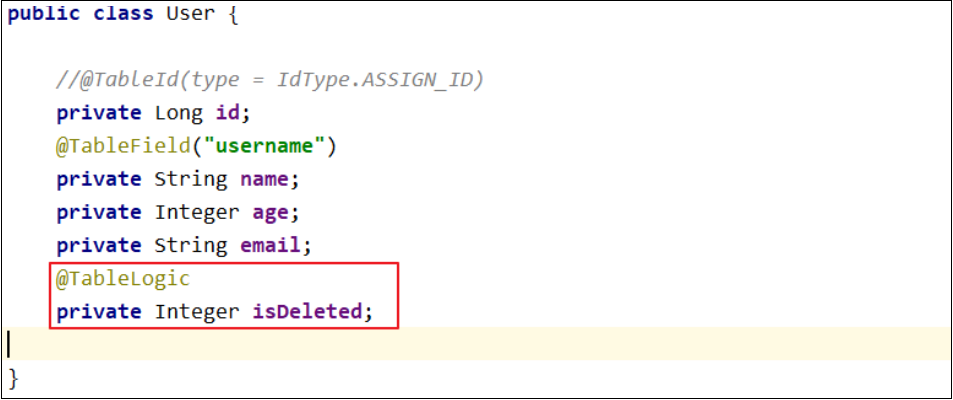
step3:测试 测试删除功能,真正执行的是修改 UPDATE t_user SET is_deleted=1 WHERE id=? AND is_deleted=0 测试查询功能,被逻辑删除的数据默认不会被查询 SELECT id,username AS name,age,email,is_deleted FROM t_user WHERE is_deleted=0
五、条件构造器和常用接口
1、wapper介绍
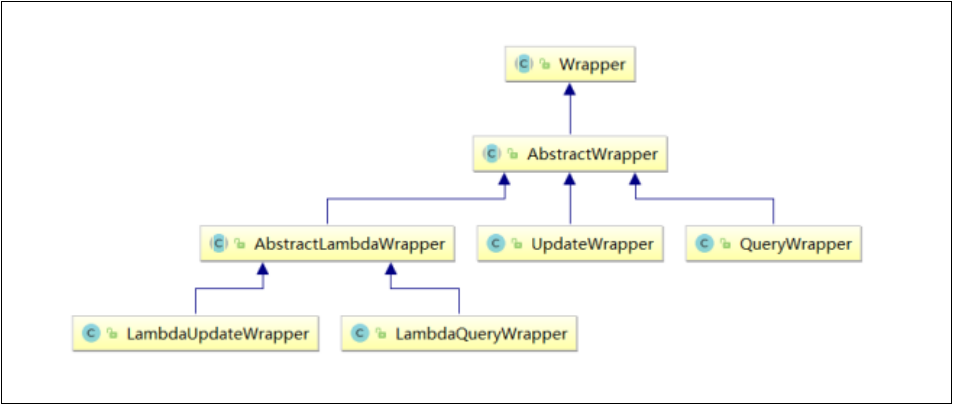
- Wrapper : 条件构造抽象类,最顶端父类
- AbstractWrapper : 用于查询条件封装,生成 sql 的 where 条件
- QueryWrapper : 查询条件封装
- UpdateWrapper : Update 条件封装
- AbstractLambdaWrapper : 使用Lambda 语法
- LambdaQueryWrapper :用于Lambda语法使用的查询Wrapper
- LambdaUpdateWrapper : Lambda 更新封装Wrapper
2、QueryWrapper
a>例1:组装查询条件
@Testpublic void test01(){//查询用户名包含a,年龄在20到30之间,并且邮箱不为null的用户信息//SELECT id,username AS name,age,email,is_deleted FROM t_user WHEREis_deleted=0 AND (username LIKE ? AND age BETWEEN ? AND ? AND email IS NOT NULL)QueryWrapper<User> queryWrapper = new QueryWrapper<>();queryWrapper.like("username", "a").between("age", 20, 30).isNotNull("email");List<User> list = userMapper.selectList(queryWrapper);list.forEach(System.out::println);}
b>例2:组装排序条件
@Testpublic void test02(){//按年龄降序查询用户,如果年龄相同则按id升序排列//SELECT id,username AS name,age,email,is_deleted FROM t_user WHEREis_deleted=0 ORDER BY age DESC,id ASCQueryWrapper<User> queryWrapper = new QueryWrapper<>();queryWrapper.orderByDesc("age").orderByAsc("id");List<User> users = userMapper.selectList(queryWrapper);users.forEach(System.out::println);}
c>例3:组装删除条件
@Testpublic void test03(){//删除email为空的用户//DELETE FROM t_user WHERE (email IS NULL)QueryWrapper<User> queryWrapper = new QueryWrapper<>();queryWrapper.isNull("email");//条件构造器也可以构建删除语句的条件int result = userMapper.delete(queryWrapper);System.out.println("受影响的行数:" + result);}
d>例4:条件的优先级
@Testpublic void test04() {QueryWrapper<User> queryWrapper = new QueryWrapper<>();//将(年龄大于20并且用户名中包含有a)或邮箱为null的用户信息修改//UPDATE t_user SET age=?, email=? WHERE (username LIKE ? AND age > ? OR email IS NULL)queryWrapper.like("username", "a").gt("age", 20).or().isNull("email");User user = new User();user.setAge(18);user.setEmail("user@atguigu.com");int result = userMapper.update(user, queryWrapper);System.out.println("受影响的行数:" + result);}
@Testpublic void test04() {QueryWrapper<User> queryWrapper = new QueryWrapper<>();//将(年龄大于20或邮箱为null)并且用户名中包含有a的用户信息修改//UPDATE t_user SET age=?, email=? WHERE (username LIKE ? AND (age > ? OR email IS NULL))//lambda表达式内的逻辑优先运算queryWrapper.like("username", "a").and(i -> i.gt("age", 20).or().isNull("email"));User user = new User();user.setAge(18);user.setEmail("user@atguigu.com");int result = userMapper.update(user, queryWrapper);System.out.println("受影响的行数:" + result);}
e>例5:组装select子句
@Testpublic void test05() {//查询用户信息的username和age字段//SELECT username,age FROM t_userQueryWrapper<User> queryWrapper = new QueryWrapper<>();queryWrapper.select("username", "age");//selectMaps()返回Map集合列表,通常配合select()使用,避免User对象中没有被查询到的列值为nullList<Map<String, Object>> maps = userMapper.selectMaps(queryWrapper);maps.forEach(System.out::println);}
f>例6:实现子查询
@Testpublic void test06() {//查询id小于等于3的用户信息//SELECT id,username AS name,age,email,is_deleted FROM t_user WHERE (id IN (select id from t_user where id <= 3))QueryWrapper<User> queryWrapper = new QueryWrapper<>();queryWrapper.inSql("id", "select id from t_user where id <= 3");//selectObjs的使用场景:只返回一列List<Object> objects = userMapper.selectObjs(queryWrapper);objects.forEach(System.out::println);}
3、UpdateWrapper
@Testpublic void test07() {//将(年龄大于20或邮箱为null)并且用户名中包含有a的用户信息修改//组装set子句以及修改条件UpdateWrapper<User> updateWrapper = new UpdateWrapper<>();//lambda表达式内的逻辑优先运算updateWrapper.set("age", 18).set("email", "user@atguigu.com").like("username", "a").and(i -> i.gt("age", 20).or().isNull("email"));//这里必须要创建User对象,否则无法应用自动填充。如果没有自动填充,可以设置为null//UPDATE t_user SET username=?, age=?,email=? WHERE (username LIKE ? AND (age > ? OR email IS NULL))//User user = new User();//user.setName("张三");//int result = userMapper.update(user, updateWrapper);//UPDATE t_user SET age=?,email=? WHERE (username LIKE ? AND (age > ? OR email IS NULL))int result = userMapper.update(null, updateWrapper);System.out.println(result);}
4、condition
在真正开发的过程中,组装条件是常见的功能,而这些条件数据来源于用户输入,是可选的,因此我们在组装这些条件时,必须先判断用户是否选择了这些条件,若选择则需要组装该条件,若没有选择则一定不能组装,以免影响SQL执行的结果
- AbstractWrapper : 用于查询条件封装,生成 sql 的 where 条件
思路一:
@Testpublic void test08() {//定义查询条件,有可能为null(用户未输入或未选择)String username = null;Integer ageBegin = 10;Integer ageEnd = 24;QueryWrapper<User> queryWrapper = new QueryWrapper<>();//StringUtils.isNotBlank()判断某字符串是否不为空且长度不为0且不由空白符(whitespace) 构成if(StringUtils.isNotBlank(username)){queryWrapper.like("username","a");}if(ageBegin != null){queryWrapper.ge("age", ageBegin);}if(ageEnd != null){queryWrapper.le("age", ageEnd);}//SELECT id,username AS name,age,email,is_deleted FROM t_user WHERE (age >= ? AND age <= ?)List<User> users = userMapper.selectList(queryWrapper);users.forEach(System.out::println);}
思路二:
上面的实现方案没有问题,但是代码比较复杂,我们可以使用带condition参数的重载方法构建查询条件,简化代码的编写
@Testpublic void test08UseCondition() {//定义查询条件,有可能为null(用户未输入或未选择)String username = null;Integer ageBegin = 10;Integer ageEnd = 24;QueryWrapper<User> queryWrapper = new QueryWrapper<>();//StringUtils.isNotBlank()判断某字符串是否不为空且长度不为0且不由空白符(whitespace)构成queryWrapper.like(StringUtils.isNotBlank(username), "username", "a").ge(ageBegin != null, "age", ageBegin).le(ageEnd != null, "age", ageEnd);//SELECT id,username AS name,age,email,is_deleted FROM t_user WHERE (age >= ? AND age <= ?)List<User> users = userMapper.selectList(queryWrapper);users.forEach(System.out::println);}
5、LambdaQueryWrapper
@Testpublic void test09() {//定义查询条件,有可能为null(用户未输入)String username = "a";Integer ageBegin = 10;Integer ageEnd = 24;LambdaQueryWrapper<User> queryWrapper = new LambdaQueryWrapper<>();//避免使用字符串表示字段,防止运行时错误queryWrapper.like(StringUtils.isNotBlank(username), User::getName, username).ge(ageBegin != null, User::getAge, ageBegin).le(ageEnd != null, User::getAge, ageEnd);List<User> users = userMapper.selectList(queryWrapper);users.forEach(System.out::println);}
6、LambdaUpdateWrapper
@Testpublic void test10() {//组装set子句LambdaUpdateWrapper<User> updateWrapper = new LambdaUpdateWrapper<>();updateWrapper.set(User::getAge, 18).set(User::getEmail, "user@atguigu.com").like(User::getName, "a").and(i -> i.lt(User::getAge, 24).or().isNull(User::getEmail)); //lambda表达式内的逻辑优先运算User user = new User();int result = userMapper.update(user, updateWrapper);System.out.println("受影响的行数:" + result);}
六、插件
1、分页插件
MyBatis Plus自带分页插件,只要简单的配置即可实现分页功能
a>添加配置
<bean class="com.baomidou.mybatisplus.extension.spring.MybatisSqlSessionFactoryBean"><property name="configLocation" value="classpath:mybatis-config.xml"></property><property name="dataSource" ref="dataSource"></property><property name="typeAliasesPackage" value="com.atguigu.mp.pojo"></property><property name="globalConfig" ref="globalConfig"></property><!--配置插件--><property name="plugins"><array><ref bean="mybatisPlusInterceptor"></ref></array></property></bean><!--配置MyBatis-Plus插件--><bean id="mybatisPlusInterceptor"class="com.baomidou.mybatisplus.extension.plugins.MybatisPlusInterceptor"><property name="interceptors"><list><ref bean="paginationInnerInterceptor"></ref></list></property></bean><!--配置MyBatis-Plus分页插件的bean--><bean id="paginationInnerInterceptor"class="com.baomidou.mybatisplus.extension.plugins.inner.PaginationInnerInterceptor"><!--设置数据库类型--><property name="dbType" value="MYSQL"></property></bean>
b>测试
@Testpublic void testPage(){//设置分页参数Page<User> page = new Page<>(1, 5);userMapper.selectPage(page, null);//获取分页数据List<User> list = page.getRecords();list.forEach(System.out::println);System.out.println("当前页:"+page.getCurrent());System.out.println("每页显示的条数:"+page.getSize());System.out.println("总记录数:"+page.getTotal());System.out.println("总页数:"+page.getPages());System.out.println("是否有上一页:"+page.hasPrevious());System.out.println("是否有下一页:"+page.hasNext());}
测试结果: User(id=1, name=Jone, age=18, email=test1@baomidou.com, isDeleted=0) User(id=2,name=Jack, age=20, email=test2@baomidou.com, isDeleted=0) User(id=3, name=Tom,age=28, email=test3@baomidou.com, isDeleted=0) User(id=4, name=Sandy, age=21,email=test4@baomidou.com, isDeleted=0) User(id=5, name=Billie, age=24, email=test5@baomidou.com, isDeleted=0) 当前页:1 每页显示的条数:5 总记录数:17 总页数:4 是否有上一页:false 是否有下一页:true
2、xml自定义分页
a>UserMapper中定义接口方法
/*** 根据年龄查询用户列表,分页显示* @param page 分页对象,xml中可以从里面进行取值,传递参数 Page 即自动分页,必须放在第一位* @param age 年龄* @return*/IPage<User> selectPageVo(@Param("page") Page<User> page, @Param("age") Integer age);
b>UserMapper.xml中编写SQL
<!--SQL片段,记录基础字段--><sql id="BaseColumns">id,username,age,email</sql><!--IPage<User> selectPageVo(Page<User> page, Integer age);--><select id="selectPageVo" resultType="User">SELECT <include refid="BaseColumns"></include> FROM t_user WHERE age > #{age}</select>
c>测试
@Testpublic void testSelectPageVo(){//设置分页参数Page<User> page = new Page<>(1, 5);userMapper.selectPageVo(page, 20);//获取分页数据List<User> list = page.getRecords();list.forEach(System.out::println);System.out.println("当前页:"+page.getCurrent());System.out.println("每页显示的条数:"+page.getSize());System.out.println("总记录数:"+page.getTotal());System.out.println("总页数:"+page.getPages());System.out.println("是否有上一页:"+page.hasPrevious());System.out.println("是否有下一页:"+page.hasNext());}
结果: User(id=3, name=Tom, age=28, email=test3@baomidou.com, isDeleted=null) User(id=4,name=Sandy, age=21, email=test4@baomidou.com, isDeleted=null) User(id=5, name=Billie,age=24, email=test5@baomidou.com, isDeleted=null) User(id=8, name=ybc1, age=21,email=null, isDeleted=null) User(id=9, name=ybc2, age=22, email=null, isDeleted=null) 当前页:1 每页显示的条数:5 总记录数:12 总页数:3 是否有上一页:false 是否有下一页:true
3、乐观锁
a>场景
一件商品,成本价是80元,售价是100元。老板先是通知小李,说你去把商品价格增加50元。小李正在玩游戏,耽搁了一个小时。正好一个小时后,老板觉得商品价格增加到150元,价格太高,可能会影响销量。又通知小王,你把商品价格降低30元。 此时,小李和小王同时操作商品后台系统。小李操作的时候,系统先取出商品价格100元;小王也在操作,取出的商品价格也是100元。小李将价格加了50元,并将100+50=150元存入了数据库;小王将商品减了30元,并将100-30=70元存入了数据库。是的,如果没有锁,小李的操作就完全被小王的覆盖了。 现在商品价格是70元,比成本价低10元。几分钟后,这个商品很快出售了1千多件商品,老板亏1万多。
b>乐观锁与悲观锁
上面的故事,如果是乐观锁,小王保存价格前,会检查下价格是否被人修改过了。如果被修改过了,则重新取出的被修改后的价格,150元,这样他会将120元存入数据库。 如果是悲观锁,小李取出数据后,小王只能等小李操作完之后,才能对价格进行操作,也会保证最终的价格是120元。
c>模拟修改冲突
数据库中增加商品表
CREATE TABLE t_product(id BIGINT(20) NOT NULL COMMENT '主键ID',NAME VARCHAR(30) NULL DEFAULT NULL COMMENT '商品名称',price INT(11) DEFAULT 0 COMMENT '价格',VERSION INT(11) DEFAULT 0 COMMENT '乐观锁版本号',PRIMARY KEY (id));
添加数据
INSERT INTO t_product (id, NAME, price) VALUES (1, '外星人笔记本', 100);
添加实体
package com.atguigu.mybatisplus.entity;import lombok.Data;@Datapublic class Product {private Long id;private String name;private Integer price;private Integer version;}
添加mapper
public interface ProductMapper extends BaseMapper<Product> {}
测试
@Testpublic void testConcurrentUpdate() {//1、小李Product p1 = productMapper.selectById(1L);System.out.println("小李取出的价格:" + p1.getPrice());//2、小王Product p2 = productMapper.selectById(1L);System.out.println("小王取出的价格:" + p2.getPrice());//3、小李将价格加了50元,存入了数据库p1.setPrice(p1.getPrice() + 50);int result1 = productMapper.updateById(p1);System.out.println("小李修改结果:" + result1);//4、小王将商品减了30元,存入了数据库p2.setPrice(p2.getPrice() - 30);int result2 = productMapper.updateById(p2);System.out.println("小王修改结果:" + result2);//最后的结果Product p3 = productMapper.selectById(1L);//价格覆盖,最后的结果:70System.out.println("最后的结果:" + p3.getPrice());}
d>乐观锁实现流程
数据库中添加version字段 取出记录时,获取当前version SELECT id,
name,price,versionFROM product WHERE id=1 更新时,version + 1,如果where语句中的version版本不对,则更新失败 UPDATE product SET price=price+50,version=version+ 1 WHERE id=1 ANDversion=1
e>Mybatis-Plus实现乐观锁
修改实体类
package com.atguigu.mybatisplus.entity;import com.baomidou.mybatisplus.annotation.Version;import lombok.Data;@Datapublic class Product {private Long id;private String name;private Integer price;@Versionprivate Integer version;}
添加乐观锁插件配置
<!--配置MyBatis-Plus插件--><bean id="mybatisPlusInterceptor"class="com.baomidou.mybatisplus.extension.plugins.MybatisPlusInterceptor"><property name="interceptors"><list><ref bean="paginationInnerInterceptor"></ref><ref bean="optimisticLockerInnerInterceptor"></ref></list></property></bean><!--配置乐观锁插件--><bean id="optimisticLockerInnerInterceptor"class="com.baomidou.mybatisplus.extension.plugins.inner.OptimisticLockerInnerInterceptor"></bean>
测试修改冲突
小李查询商品信息: SELECT id,name,price,version FROM t_product WHERE id=? 小王查询商品信息: SELECT id,name,price,version FROM t_product WHERE id=? 小李修改商品价格,自动将version+1 UPDATE t_product SET name=?, price=?, version=? WHERE id=? AND version=? Parameters: 外星人笔记本(String), 150(Integer), 1(Integer), 1(Long), 0(Integer) 小王修改商品价格,此时version已更新,条件不成立,修改失败 UPDATE t_product SET name=?, price=?, version=? WHERE id=? AND version=? Parameters: 外星人笔记本(String), 70(Integer), 1(Integer), 1(Long), 0(Integer) 最终,小王修改失败,查询价格:150 SELECT id,name,price,version FROM t_product WHERE id=?
优化流程
@Testpublic void testConcurrentVersionUpdate() {//小李取数据Product p1 = productMapper.selectById(1L);//小王取数据Product p2 = productMapper.selectById(1L);//小李修改 + 50p1.setPrice(p1.getPrice() + 50);int result1 = productMapper.updateById(p1);System.out.println("小李修改的结果:" + result1);//小王修改 - 30p2.setPrice(p2.getPrice() - 30);int result2 = productMapper.updateById(p2);System.out.println("小王修改的结果:" + result2);if(result2 == 0){//失败重试,重新获取version并更新p2 = productMapper.selectById(1L);p2.setPrice(p2.getPrice() - 30);result2 = productMapper.updateById(p2);}System.out.println("小王修改重试的结果:" + result2);//老板看价格Product p3 = productMapper.selectById(1L);System.out.println("老板看价格:" + p3.getPrice());}
七、通用枚举
表中的有些字段值是固定的,例如性别(男或女),此时我们可以使用MyBatis-Plus的通用枚举来实现
a>数据库表添加字段sex
b>创建通用枚举类型
package com.atguigu.mp.enums;import com.baomidou.mybatisplus.annotation.EnumValue;import lombok.Getter;@Getterpublic enum SexEnum {MALE(1, "男"),FEMALE(2, "女");@EnumValueprivate Integer sex;private String sexName;SexEnum(Integer sex, String sexName) {this.sex = sex;this.sexName = sexName;}}
c>配置扫描通用枚举
<beanclass="com.baomidou.mybatisplus.extension.spring.MybatisSqlSessionFactoryBean"><property name="configLocation" value="classpath:mybatis-config.xml"></property><property name="dataSource" ref="dataSource"></property><property name="typeAliasesPackage" value="com.atguigu.mp.pojo"></property><!-- 设置MyBatis-Plus的全局配置 --><property name="globalConfig" ref="globalConfig"></property><!-- 配置扫描通用枚举 --><property name="typeEnumsPackage" value="com.atguigu.mp.enums"></property></bean>
d>测试
@Testpublic void testSexEnum(){User user = new User();user.setName("Enum");user.setAge(20);//设置性别信息为枚举项,会将@EnumValue注解所标识的属性值存储到数据库user.setSex(SexEnum.MALE);//INSERT INTO t_user ( username, age, sex ) VALUES ( ?, ?, ? )//Parameters: Enum(String), 20(Integer), 1(Integer)userMapper.insert(user);}
八、代码生成器
1、引入依赖
<dependency><groupId>com.baomidou</groupId><artifactId>mybatis-plus-generator</artifactId><version>3.5.1</version></dependency><dependency><groupId>org.freemarker</groupId><artifactId>freemarker</artifactId><version>2.3.31</version></dependency>
2、快速生成
public class FastAutoGeneratorTest {public static void main(String[] args) {FastAutoGenerator.create("jdbc:mysql://127.0.0.1:3306/mybatis_plus","root", "123456").globalConfig(builder -> {builder.author("atguigu") // 设置作者//.enableSwagger() // 开启 swagger 模式.fileOverride() // 覆盖已生成文件.outputDir("D://mybatis_plus"); // 指定输出目录}).packageConfig(builder -> {builder.parent("com.atguigu") // 设置父包名.moduleName("mybatisplus") // 设置父包模块名.pathInfo(Collections.singletonMap(OutputFile.mapperXml, "D://mybatis_plus"));// 设置mapperXml生成路径}).strategyConfig(builder -> {builder.addInclude("t_user") // 设置需要生成的表名.addTablePrefix("t_", "c_"); // 设置过滤表前缀}).templateEngine(new FreemarkerTemplateEngine()) // 使用Freemarker引擎模板,默认的是Velocity引擎模板.execute();}}
九、MyBatisX插件
MyBatis-Plus为我们提供了强大的mapper和service模板,能够大大的提高开发效率 但是在真正开发过程中,MyBatis-Plus并不能为我们解决所有问题,例如一些复杂的SQL,多表联查,我们就需要自己去编写代码和SQL语句,我们该如何快速的解决这个问题呢,这个时候可以使用MyBatisX插件 MyBatisX一款基于 IDEA 的快速开发插件,为效率而生。
MyBatisX插件用法:https://baomidou.com/pages/ba5b24/


